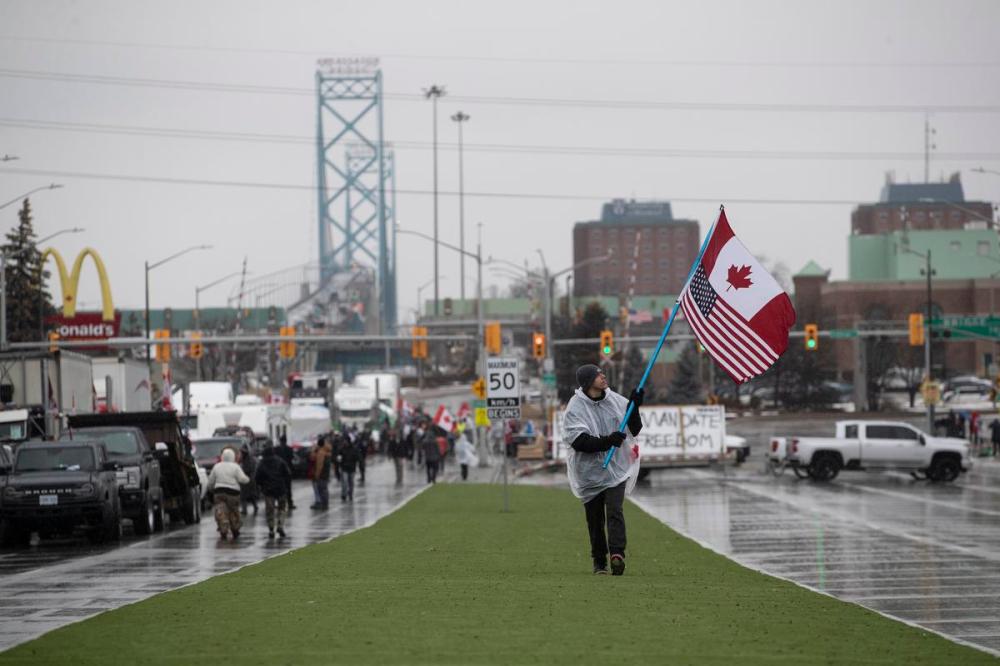What is Zello? Inside the app that helped organize “freedom convoy” blockades
Advertisement
Read this article for free:
or
Already have an account? Log in here »
To continue reading, please subscribe:
Monthly Digital Subscription
$0 for the first 4 weeks*
- Enjoy unlimited reading on winnipegfreepress.com
- Read the E-Edition, our digital replica newspaper
- Access News Break, our award-winning app
- Play interactive puzzles
*No charge for 4 weeks then price increases to the regular rate of $19.00 plus GST every four weeks. Offer available to new and qualified returning subscribers only. Cancel any time.
Monthly Digital Subscription
$4.75/week*
- Enjoy unlimited reading on winnipegfreepress.com
- Read the E-Edition, our digital replica newspaper
- Access News Break, our award-winning app
- Play interactive puzzles
*Billed as $19 plus GST every four weeks. Cancel any time.
To continue reading, please subscribe:
Add Free Press access to your Brandon Sun subscription for only an additional
$1 for the first 4 weeks*
*Your next subscription payment will increase by $1.00 and you will be charged $16.99 plus GST for four weeks. After four weeks, your payment will increase to $23.99 plus GST every four weeks.
Read unlimited articles for free today:
or
Already have an account? Log in here »
Hey there, time traveller!
This article was published 11/02/2022 (1372 days ago), so information in it may no longer be current.
With the “freedom convoy” siege in Ottawa and blockade on the Ambassador Bridge, Ontario has called a state of emergency, awaiting an injunction hearing to determine if police can forcibly move drivers off the roads.
But just how did these demonstrations come to be? A big part of the organization for protest leaders of the “freedom convoy” across Canada was through the communication app Zello — which coordinated the meeting of hundreds of truck drivers and their supporters to specific locations.
The “freedom convoy” is also using Zello as a tool to muster morale and a sort of kinship among protesters, with members participating in everything from national anthem sing-a-longs to consulting one another on which eateries will allow people to dine without a vaccine passport.

Here’s a breakdown of how the app works:
What is Zello?
Zello is an instant communication, push-to-talk live voice app that can be downloaded on a smartphone. Similar to walkie-talkies, the app allows for easy, chat room style communication between users or with a larger group of people through channels. Unlike standard calls, the app requires an internet connection either through a service provider or Wi-Fi, and connects users across the world.
Private voice messages on the app are end-to-end encrypted — meaning they are protected to prevent data from being read or secretly changed by anyone other than the users in conversation.
However, public channels, like the ones used for organizing the “freedom convoy” that allow people to share messages in a large group are not encrypted. Some of these channels are public, meaning anyone can join and listen in at a capacity of up to 7,000 users.
It’s also possible to send texts and images through the app.
How was Zello used in the “freedom convoy?”
Across Canada, multiple Zello channels have popped up as a tool for organizing the “freedom convoy” protests or blockades. For the Ambassador Bridge blockade, a channel called “windsor convoy 2” was used for protesters to communicate plans to “hold the line.” But due to a recent hack, users fled the channel.
Despite Zello’s ability to organize mass groups, the channels with public access may be prone to trolls or hacks. This week, protesters in the “windsor convoy 2” channel were faced with the #RamRanchResistance, a group of counterprotesters that attempted to disrupt the flow of information by playing a graphic LGBTQ porno-metal song, “Ram Ranch” by Canadian artist Grant McDonald.
Posing as a part of the convoy, counterprotesters infiltrated the channel by posing as members of the movement, which gave them access to speak and join the channel’s communications. The counterprotesters infilitrated by playing this track, pushing members to flee and start new channels.
What was Zello made for?
Zello can be used for many different reasons depending on the user’s intentions. Originally, the app was “built for the frontline,” Zello’s website reads, but can be used by everyone.
Zello is used often by construction workers, truck drivers, taxi and delivery dispatchers and others in construction and transportation industries. The app is also used by first responders to locate and communicate over a clear connection that has no decrease in audio quality despite distances.
When has Zello been used before?
With the app’s simple interface and immediate correspondence Zello has been useful in past events.
During the 2014 Venezuelan protests under Nicolás Maduro, Zello was widely used to communicate and organize protests. While it was blocked by CANTV, a state-run service provider, Zello issued patches to bypass the blocks to support about 600,000 Venezuelans who downloaded the app. Zello was the also the most downloaded app in Turkey during the 2013 protests, used to circumvent government censors.
During hurricanes Harvey and Florence in 2017 and 2018, Zello was a popular mode of communication to contact those stranded in floods.
Demar Grant is a Toronto-based staff reporter for the Star. Reach Demar via Twitter: @demarjgrant

